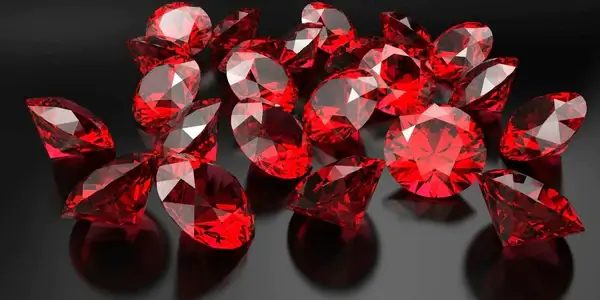If you’ve ever seen a pink ruby, you may have wondered if it is as valuable as a red ruby. The answer is not as straightforward as you may think. Although pink rubies are not as standard as red rubies, they can still be worth a significant amount of money, depending on their quality and rarity. This blog post will explore the value of pink rubies and discuss how they compare to their red counterparts.
What Are The Different Types Of Rubies?
Rubies are a variety of mineral corundum, which come in many colors and types. Rubies can range from deep red to pinkish red, as well as purplish and orange-red hues. Rubies with a solid blue hue are known as sapphires. In addition to these traditional ruby colors, there is also a variety of treated rubies, including those with star-like patterns, color-changing rubies, and a mystic topaz effect. All of these different types of rubies have their unique beauty and rarity. However, pink rubies stand out for their relative rarity among these rubies.
As such, they often command higher prices than other colored gems like sapphires or even red rubies. Some of the most stunning pink rubies display “mystic topaz” properties, creating an iridescent rainbow of colors due to light refraction within the stone. Gem collectors especially value mystic topaz rubies because they often display vivid blues and greens that cannot be seen in other gemstones. This phenomenon is believed to occur due to tiny rutile needles within the ruby that cause light rays to diffract and create an array of captivating colors. Mystic topaz’s effects on rare pink rubies make them significantly sought after by gem enthusiasts.
Where Are Rubies Found?
Rubies are found in various locations worldwide, with some of the most notable sources being Myanmar (Burma), Thailand, India, and Afghanistan. Rubies from different areas can have other properties and color variations, such as pinkish or mystic topaz. However, the most sought-after rubies tend to be from Myanmar. These rubies are known for their rich, deep red color and superior quality. Rubies are also found in Sri Lanka, Tanzania, Madagascar, Vietnam, Pakistan, and even the United States.
How Are Rubies Graded?
The 4 Cs determine the quality of rubies: color, clarity, cut, and carat. Color is the most critical factor in determining the value of a ruby. Generally, the higher the color saturation and brighter the hue, the more valuable the ruby. Clarity also affects the price; rubies that are clear with few blemishes or inclusions will fetch a higher price than those that are cloudy or foggy.
The cut is also essential when grading a ruby. A well-cut ruby should have sharp edges and an even shape that allows light to reflect off its surface. The cut should be symmetrical and proportioned appropriately. The ruby’s carat size, or weight, is the final factor in grading. The heavier the ruby, the more expensive it is likely to be.
In addition to these factors, the type of ruby can influence its value. Rubies come in many colors, from traditional red to rare shades such as pink or purple. In some cases, even more, occasional gems, such as mystic topaz, may be included in the mix, further adding to the value of the ruby.
What Factors Affect Ruby Prices?
Ruby prices vary greatly, depending on the stone’s color, clarity, size, cut, and origin. Generally, the more vivid the color of a ruby is, the higher its value will be. The most valuable rubies tend to have a deep red hue with just a hint of blue. Clarity can also significantly impact the price; rubies free of inclusions, flaws, and blemishes tend to be the most sought-after.
The size of a ruby also affects its price. Larger rubies tend to be more expensive than smaller ones. A well-cut ruby with good symmetry and an attractive shape will command a higher price than one poorly cut. Finally, the origin of the ruby can also have an impact on its value. For example, rubies mined in Myanmar (Burma) are some of the most highly-prized rubies in the world and, therefore, command higher prices.
In addition to the factors mentioned above, specific treatments and enhancements can also increase the value of a ruby. A popular treatment is known as “mystic topaz” involves infusing the ruby with special coatings to create a unique rainbow effect. Such enhancements make rubies even more desirable and valuable.
How Can You Tell If A Ruby Is Real?
It can be difficult for an untrained eye to distinguish genuine rubies from other gems. Fortunately, there are specific tests you can use to determine if your ruby is natural. Here are some of the most common tests used to authenticate a ruby:
- The GIA Colour Identification System – The Gemological Institute of America has developed a system that uses color filters to measure the hue and intensity of a gemstone. This system can accurately tell the difference between natural and synthetic ruby.
- The Rubidium Test – A more advanced form of testing involves using a rubidium solution to identify trace elements in the gemstone. Natural rubies will contain certain trace elements not present in synthetic rubies or imitation stones such as mystic topaz.
- Refractometer Testing – Using a refractometer, you can measure the amount of light a gemstone refracts and reflects. This will provide an accurate measurement of the stone’s refractive index, which is unique to genuine rubies and can distinguish them from imitations.
Using one or more of these tests, you should be able to tell if a ruby is genuine. However, it is always recommended that you seek advice from a professional jeweler or gemologist when authenticating expensive or valuable stones.

Average Rating